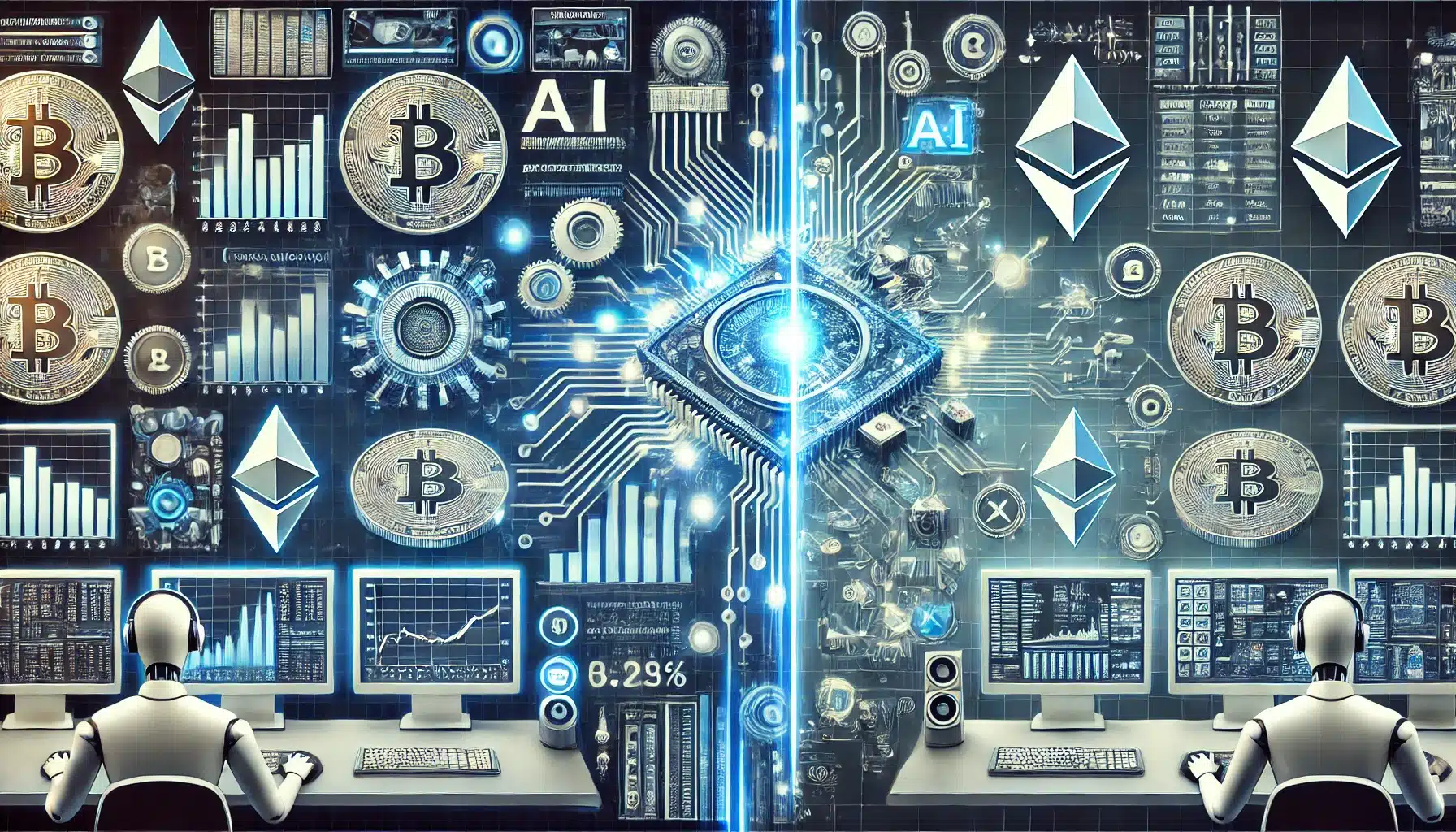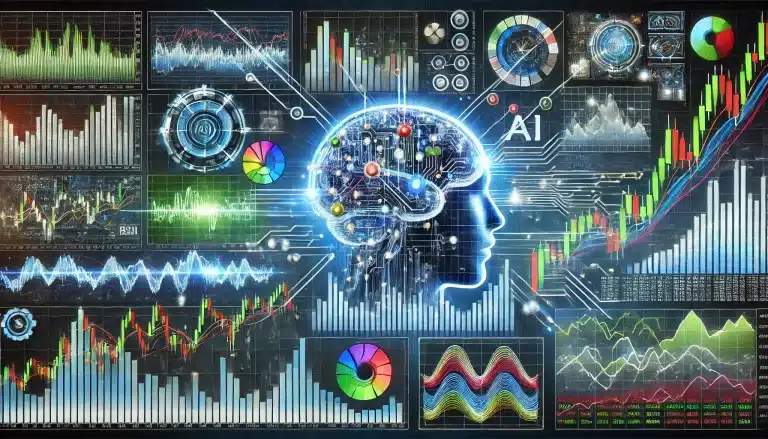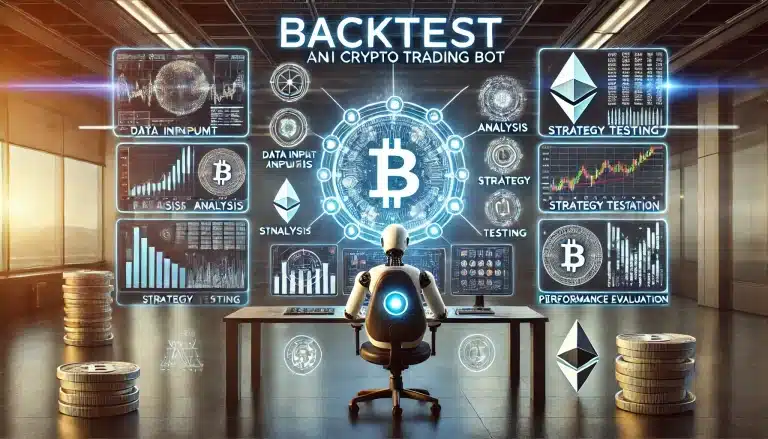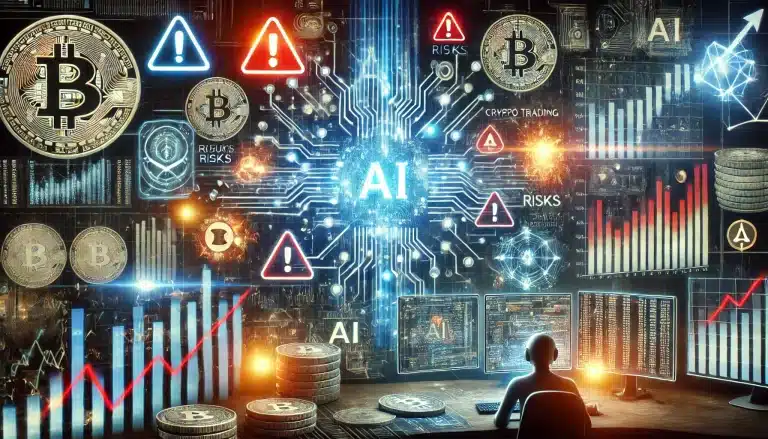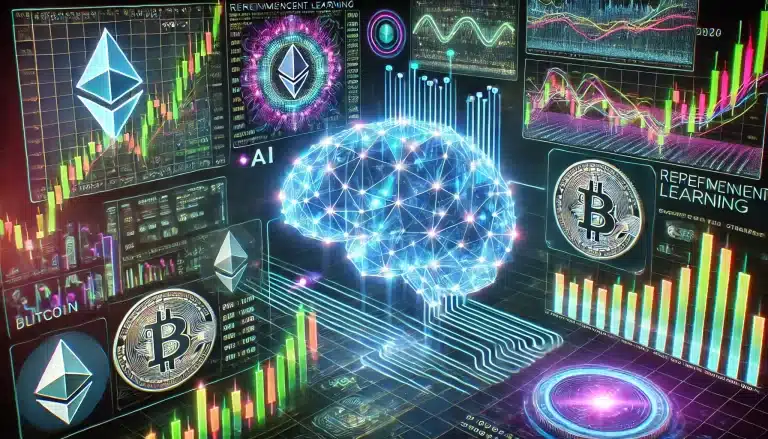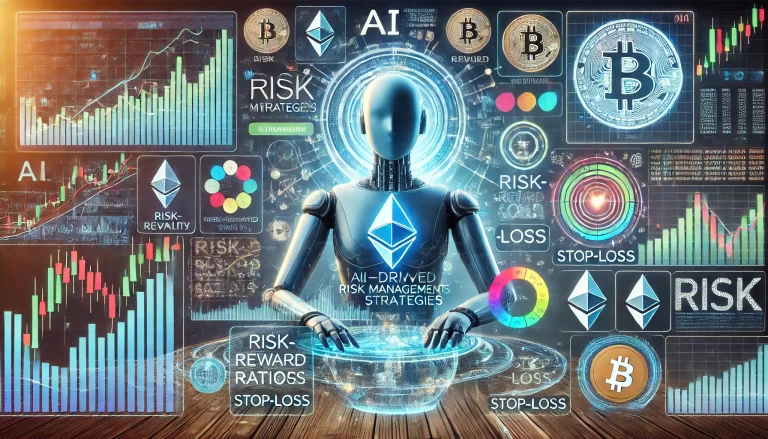Imagine a world where machines and humans go head-to-head in the crypto arena.
Welcome to 2025, where this isn’t science fiction – it’s reality!
Did you know that AI-powered trading systems now account for over 70% of daily trading volume in traditional financial markets?
But how does this translate to the wild west of crypto? Buckle up as we explore the thrilling battle between AI and traditional trading in the ever-volatile cryptocurrency markets!
The Rise of AI in Crypto Trading
Okay, let me tell you about my journey with AI in crypto trading. It’s been quite the rollercoaster, lemme tell ya!
I remember when I first dipped my toes into the crypto world. Man, was I clueless! I’d spend hours staring at charts, trying to make sense of all those squiggly lines. It was like trying to read hieroglyphics while riding a unicycle. Not pretty.
Then one day, I stumbled across this article about AI in crypto trading. My mind was blown! Could machines really do all this complex analysis better than us humans? I was skeptical, but intrigued.
So, I decided to give it a shot. I started with a simple machine learning algorithm for predicting Bitcoin prices. Let’s just say my first attempt was… less than stellar. My algorithm somehow predicted that Bitcoin would be worth negative $500 by the end of the week. Oops!
But I didn’t give up. I kept learning, tweaking, and improving. And you know what? Things started to click. My AI models began to spot patterns I’d never noticed before. It was like having a super-smart trading buddy who never slept or got distracted by cat videos (guilty as charged).
Now, I’m not saying AI is perfect. Far from it! There’ve been plenty of hiccups along the way. Like the time my natural language processing model interpreted a tweet about “crypto winter” literally and tried to buy a bunch of digital snow shovels. Yeah, that wasn’t my finest moment.
But overall, the rise of AI in crypto trading has been pretty darn impressive. These days, we’ve got deep learning models that can crunch through mountains of data in seconds. It’s like having a financial crystal ball, except it runs on electricity instead of magic.
One thing that’s really caught my eye is how AI is being used for sentiment analysis. It’s wild – these algorithms can scan through millions of social media posts and figure out if the crypto crowd is feeling bullish or bearish. Talk about taking the pulse of the market!
Of course, not all AI trading platforms are created equal. I’ve tested out a bunch, and let me tell you, some of them are about as useful as a chocolate teapot. But there are a few gems out there that have seriously upped my trading game.
The key, I’ve found, is to understand what these AI tools are actually doing. They’re not magic boxes that print money (wouldn’t that be nice?). They’re tools that can help us make smarter, faster decisions. But at the end of the day, we still need to be in the driver’s seat.
Looking back, it’s crazy to think how far we’ve come. From those early days of basic algorithms to the sophisticated AI trading systems we have now, it’s been one heck of a ride. And the best part? We’re just getting started.
So, if you’re thinking about diving into the world of AI crypto trading, my advice is this: start small, be patient, and never stop learning. Oh, and maybe double-check before you buy any digital snow shovels. Trust me on that one.
Traditional Crypto Trading Strategies
Alright, let’s talk about good ol’ traditional crypto trading strategies. You know, the stuff we were doing before the robots took over. Just kidding… sort of.
I gotta admit, when I first started trading crypto, I thought I was gonna be the next Warren Buffett of the digital age. Spoiler alert: I wasn’t. My first attempts at trading were about as graceful as a bull in a china shop. But hey, we all gotta start somewhere, right?
Let’s dive into fundamental analysis first. This is where you put on your detective hat and start digging into the nitty-gritty of a cryptocurrency project. I remember spending days poring over whitepapers, trying to understand what the heck a “decentralized autonomous organization” actually meant. It was like learning a whole new language!
But you know what? Once I got the hang of it, fundamental analysis became my secret weapon. It’s not just about the tech specs – it’s about understanding the team behind the project, their roadmap, and how they’re tackling real-world problems. Trust me, this knowledge comes in handy when the market starts doing its rollercoaster impression.
Now, onto technical analysis. Oh boy, did I struggle with this at first! All those fancy chart patterns – head and shoulders, cup and handle, double top… I felt like I was reading tea leaves instead of price data. But with practice (and a lot of coffee), things started to make sense.
I’ll never forget the first time I correctly predicted a trend reversal using a simple moving average crossover. I felt like a crypto Nostradamus! Of course, I’ve had my fair share of misses too. Like the time I was so convinced by a “textbook” bull flag pattern that I went all in… only to watch the price plummet faster than my hopes and dreams. Ouch.
When it comes to trading strategies, I’ve tried ’em all. HODLing? Been there, done that, got the t-shirt (and the gray hairs from watching my portfolio during bear markets). Day trading? Let’s just say my caffeine intake reached dangerous levels. Swing trading? Now we’re talking – it’s become my personal favorite.
Swing trading lets me capitalize on those juicy medium-term trends without being glued to my screen 24/7. Plus, it gives me time to, you know, have a life outside of crypto. Novel concept, I know!
But here’s the thing about traditional trading strategies – they require a ton of discipline and emotional control. I can’t tell you how many times I’ve been tempted to panic sell during a dip or FOMO buy during a pump. It’s like having an angel on one shoulder and a devil on the other, both screaming trading advice at you.
One lesson I’ve learned the hard way: stick to your strategy. It’s so easy to get swayed by the latest Reddit hype or a hot tip from your neighbor’s cousin’s dog walker. But consistency is key in this wild west of crypto trading.
And let’s not forget about risk management. I cringe when I think about my early days of YOLOing into random altcoins. These days, I’m all about setting stop losses, diversifying my portfolio, and never risking more than I can afford to lose. Boring? Maybe. But it helps me sleep at night.
At the end of the day, traditional crypto trading strategies are all about understanding the market, managing your emotions, and finding what works for you. It’s not always glamorous, and it definitely ain’t easy. But when you nail that perfect trade? Man, there’s no feeling like it.
So whether you’re a chart-reading wizard or a fundamentals fanatic, remember: in the world of crypto, the only constant is change. Stay adaptable, keep learning, and for Pete’s sake, don’t bet the farm on a meme coin. Trust me, I learned that one the hard way!
Performance Comparison: AI vs. Traditional Trading
Alright, folks, it’s time for the main event: AI vs. traditional trading in the crypto arena! Buckle up, ’cause this comparison is gonna be wilder than a rollercoaster ride through a thunderstorm.
So, I’ve been on both sides of this fence, and let me tell ya, it’s been one heck of a learning experience. When I first pitted my AI trading bot against my own traditional strategies, I was like a proud parent at a school sports day. “Go get ’em, little algorithm!” I cheered. But boy, was I in for a surprise.
Let’s talk historical data and backtesting results first. On paper, AI looked like the clear winner. It could analyze years of data in the blink of an eye, spotting patterns I’d never even dreamed of. My little bot was churning out impressive hypothetical gains, making my manual backtesting look like child’s play.
But here’s the kicker – real-world performance is a whole different ball game. I learned this the hard way when my AI bot had a complete meltdown during a major market crash. While I was able to keep my cool (mostly) and make some strategic moves, my bot was buying the dip… and then the dip after that… and then the dip after that. It was like watching a car crash in slow motion, but with my money!
That being said, AI has its moments of glory too. I’ll never forget the time my bot caught a sudden pump in an obscure altcoin before I’d even had my morning coffee. By the time I’d figured out what was happening, it had already taken profits and moved on. Show-off.
Now, let’s get into the nitty-gritty of pros and cons. AI trading is like having a tireless assistant who never sleeps, never gets emotional, and can crunch numbers faster than you can say “blockchain”. It’s fantastic for high-frequency trading and can spot micro-trends that human eyes might miss.
But – and it’s a big but – AI isn’t great at adapting to sudden changes or understanding context. Remember that time Elon Musk tweeted about Dogecoin and the whole market went bonkers? Yeah, my AI bot didn’t see that coming.
Traditional trading, on the other hand, shines when it comes to intuition and adaptability. There’s something to be said for gut feeling and experience, especially in the crazy world of crypto. I’ve had trades where everything looked perfect on paper, but something just felt… off. Trusting my instincts saved my bacon more than once.
The downside? We humans are emotional creatures. FOMO, panic selling, getting attached to a coin – I’ve been guilty of all these sins. And let’s not even talk about the time I fell asleep at my desk and missed a major trade opportunity. AI doesn’t have these problems (though it does occasionally try to buy digital snow shovels, but that’s another story).
In terms of overall performance, it’s not as clear-cut as you might think. In stable market conditions, my AI bot often outperforms my manual trading. But when things get volatile – which, let’s face it, is pretty much always in crypto – having a human at the helm can be a real advantage.
One thing’s for sure – the crypto market is no place for a one-size-fits-all approach. I’ve had the most success with a hybrid strategy, using AI for rapid analysis and execution while keeping a human eye on the big picture.
At the end of the day, whether you’re Team AI or Team Human, the key is to play to your strengths. Understand the pros and cons of each approach, and don’t be afraid to experiment. Just remember, in the world of crypto trading, the only constant is change. Well, that and the fact that your significant other will never understand why you’re checking your phone at 3 AM. “But honey, it’s the Asian market opening!” Ah, the joys of being a crypto trader.
Key Advantages of AI Trading in Crypto
Alright, let’s talk about why AI is making waves in the crypto world. Trust me, after my adventures with both traditional and AI trading, I’ve got some stories to tell!
First up, 24/7 market monitoring and rapid decision-making. Man, this is a game-changer! I remember the days when I’d set alarms for ungodly hours just to check the markets. My partner thought I was losing my mind – and maybe I was a little. But with AI, those sleepless nights are a thing of the past.
My AI trading bot is like that friend who never sleeps and has had way too much coffee. It’s always on, always alert, and ready to pounce on opportunities faster than you can say “to the moon!” One time, while I was busy binge-watching a new series (hey, even traders need a break), my bot caught a sudden price spike and executed a perfect trade. By the time I checked my phone, I’d already made a tidy profit. Now that’s what I call passive income!
But it’s not just about being awake all the time. The speed at which AI can analyze data and make decisions is mind-blowing. We’re talking milliseconds here, folks. In the time it takes you to blink, an AI trading system can analyze market trends, compare them to historical data, check the latest news, and execute a trade. It’s like having The Flash as your personal trading assistant.
Now, let’s talk about something that’s been a real lifesaver for me: emotion-free trading. I’ll be honest, I’ve made some pretty dumb decisions based on emotions. FOMO? Been there. Panic selling? Done that. But AI doesn’t have these problems. It doesn’t get excited about a pump or scared during a dip. It just follows its programming, executing trades based on cold, hard data.
I remember this one time when a major crypto exchange got hacked. The market was in freefall, and I was freaking out. My hands were shaking so bad I could barely type. But my AI bot? Cool as a cucumber. It stuck to its strategy, made some smart moves, and actually came out ahead while I was busy hyperventilating into a paper bag.
But here’s the real kicker – AI’s ability to analyze vast amounts of data and identify patterns. It’s like having a super-powered brain that can spot connections we mere mortals might miss. I’m talking about correlations between different coins, subtle market indicators, even sentiment analysis from social media.
There was this time when my AI system picked up on a pattern linking Bitcoin price movements to a specific economic indicator. It was so subtle I’d never have spotted it myself. But thanks to that insight, I was able to anticipate a market shift and make some pretty sweet gains.
Of course, it’s not all sunshine and rainbows. AI has its limitations (more on that later), and there’s always the risk of over-relying on technology. I learned that lesson the hard way when a bug in my system led to a series of bad trades. Ouch!
But overall, the advantages of AI in crypto trading are hard to ignore. It’s like having a tireless, emotionless, super-smart trading partner who never asks for a bathroom break. Just remember, AI is a tool, not a magic wand. You still need to understand the market, set your strategies, and keep an eye on things.
And hey, even if your AI bot makes a mistake, at least you can’t yell at it for leaving dirty dishes in the sink. Although… maybe someone should invent an AI for that too. Now there’s a million-dollar idea!
Limitations and Challenges of AI Trading
Alright, let’s get real for a minute. As much as I love my AI trading buddy, it’s not all rainbows and lambos. There are some serious limitations and challenges that come with AI trading in the crypto world. Trust me, I’ve learned about these the hard way!
First up, let’s talk about overfitting and data bias. This is a doozy, folks. I remember when I first set up my AI trading model. I was so proud of it, like a parent watching their kid graduate. This thing was predicting market movements with scary accuracy… in backtests.
But when I let it loose on the real market? Hoo boy. It was about as useful as a chocolate teapot. See, I’d unknowingly created a model that was great at predicting the past but useless for the future. It had memorized the noise in my training data instead of learning true patterns. Classic overfitting.
And don’t even get me started on data bias. One time, I accidentally trained my model using data only from a massive bull run. Guess what happened when the market turned bearish? Yep, my AI kept buying, convinced that stonks only go up. My portfolio took a hit faster than you can say “HODL”.
Now, let’s chat about adapting to sudden market shifts and black swan events. This is where AI can really show its limitations. See, AI is great at spotting patterns and trends, but it struggles with the unexpected. And if there’s one thing you can count on in crypto, it’s the unexpected.
I’ll never forget the day when a major country announced a crypto ban. The market went into a tailspin. While I was glued to the news, trying to figure out my next move, my AI was happily executing its usual strategy, completely oblivious to the chaos. It was like watching a robot try to play chess while the board was on fire.
And then there’s the regulatory minefield. Oof, this is a tough one. AI doesn’t understand concepts like “insider trading” or “market manipulation”. It just sees patterns and acts on them. This can lead to some… let’s say “ethically questionable” situations.
There was this one time when my AI started making trades based on patterns it spotted just before major exchange announcements. Turns out, it had accidentally stumbled upon a way to front-run the market. I shut that down real quick! I’d rather keep my profits legal, thank you very much.
But perhaps the biggest challenge is the potential for market manipulation. As AI trading becomes more prevalent, there’s a risk of creating self-fulfilling prophecies. If enough AI systems are following similar strategies, they could potentially move the market in unnatural ways.
I’ve seen glimpses of this already. There’ve been times when the market moved in ways that made no sense… until you consider that it might’ve been driven by AI traders all reacting to the same signals. It’s like a weird, robotic herd mentality.
And let’s not forget about the technical challenges. Maintaining an AI trading system is like trying to keep a high-performance sports car running smoothly. It needs constant tuning, updating, and troubleshooting. I can’t count the number of times I’ve had to pull all-nighters debugging my system because it suddenly decided that Dogecoin was the next Bitcoin.
Despite all these challenges, I still believe in the potential of AI trading. But it’s crucial to understand its limitations. AI is a powerful tool, but it’s not infallible. It needs human oversight, common sense, and a healthy dose of skepticism.
So, if you’re thinking about diving into AI trading, go for it! Just remember: keep one hand on the wheel, and always be ready to pull the plug if things go haywire. After all, in the wild west of crypto, sometimes good old-fashioned human intuition is your best asset.
Human Edge in Traditional Crypto Trading
Alright, let’s talk about us humans for a bit. You know, the ones with opposable thumbs and a penchant for making questionable decisions after midnight. Despite all the AI hype, we’ve still got some tricks up our sleeves when it comes to crypto trading.
First off, let’s chat about intuition and experience in interpreting market sentiment. This is where we really shine, folks. I’ve lost count of the times I’ve looked at a chart, felt a gut feeling, and made a successful trade that no AI could’ve predicted.
There was this one time during a major crypto conference. The keynote speaker was droning on about some new technology, and I could feel the room’s energy shifting. People were getting bored, checking their phones, rolling their eyes. My AI would’ve been clueless, but I knew right then that this coin was gonna tank. I sold quickly and, sure enough, it dropped like a rock the next day.
That’s the kind of nuanced understanding that’s hard to program into an algorithm. We can read between the lines, sense the mood, and make judgment calls based on a complex mix of factors that might seem unrelated to an AI.
Now, let’s talk about flexibility in adapting to geopolitical events and regulatory changes. This is where having a human brain really pays off. We can understand context, anticipate consequences, and pivot strategies on the fly.
I remember when a certain billionaire tweeted about a certain meme coin, and the whole market went bananas. My AI trading bot was utterly baffled, but I saw the writing on the wall. I quickly adjusted my strategy, rode the wave, and made a tidy profit while my bot was still trying to figure out what a “Doge” was.
Regulatory changes are another area where human traders have an edge. We can read proposed legislation, understand its implications, and adjust our strategies accordingly. AI might be able to crunch numbers, but it can’t testify before Congress (yet).
One of the biggest advantages we have is the ability to build and maintain relationships in the crypto community. This industry is still young and tight-knit, and networking can give you invaluable insights.
I’ve made some of my best trades based on casual conversations at meetups or conferences. You’d be surprised what you can learn over a beer with a dev team member or a chat with a fellow trader. My AI might be able to analyze millions of data points, but it can’t schmooze at a blockchain mixer!
There’s also something to be said for human creativity and out-of-the-box thinking. We can come up with novel strategies, see connections that aren’t obvious, and take calculated risks based on a holistic understanding of the market.
I once made a killing by noticing a correlation between a certain altcoin and a completely unrelated industry trend. It was a connection so obscure that no AI would’ve spotted it, but it paid off big time.
Of course, being human also means we’re prone to emotions and biases. I’ve definitely made my share of FOMO-driven decisions and panic sells. But you know what? Those mistakes have made me a better trader. Each loss is a lesson learned, shaping my intuition and improving my decision-making skills.
At the end of the day, the human edge in crypto trading comes down to our ability to understand the big picture, adapt quickly to change, and leverage our uniquely human skills like intuition and relationship-building.
Don’t get me wrong, I love my AI trading tools. But there’s something deeply satisfying about making a successful trade based on your own analysis and instincts. It’s like solving a complex puzzle or winning a chess game against a tough opponent.
So, to all my fellow human traders out there: don’t underestimate yourselves! We might not be able to process data at the speed of light, but we’ve got skills that no AI can match. At least not until they figure out how to program a fear of missing out or the ability to panic-buy after three beers. Until then, the human edge is real, and it’s spectacular!
Hybrid Approaches: Combining AI and Human Expertise
Alright, folks, now we’re getting to the good stuff. You know what they say – if you can’t beat ’em, join ’em. Or in this case, team up with ’em! Let’s dive into the world of hybrid approaches, where human smarts meet AI power.
I gotta tell ya, when I first started experimenting with combining AI and human trading strategies, it was like trying to teach my grandma how to use TikTok. Awkward, confusing, but ultimately kind of amazing.
Let’s start with AI-assisted trading tools for us mere mortals. These babies are game-changers! I remember the first time I used an AI-powered sentiment analysis tool. It was like having a superpower. Suddenly, I could gauge the mood of the entire crypto Twitter-sphere in seconds. No more endless scrolling and second-guessing myself!
There was this one time when my sentiment tool picked up on a growing buzz around a small-cap altcoin. The chatter was still low-key, not enough to trigger most trading bots. But I could see the trend forming. I made the call to buy in early, and boom! Two days later, it pumped like crazy. My human intuition combined with AI insights? Chef’s kiss!
Now, let’s talk about human oversight in AI-driven trading systems. This is crucial, folks. Think of it like being the responsible adult at a teenager’s party. You’re letting the kids (AI) have fun, but you’re there to make sure nobody burns the house down.
I learned this lesson the hard way when my AI bot went on a buying spree during a flash crash. It saw falling prices and thought, “Buy the dip!” Problem was, it kept buying… and buying… and buying. By the time I noticed, it had blown through half my trading budget. Now, I always keep a watchful eye on my AI sidekick, ready to pull the plug if things get weird.
But here’s where it gets really interesting – the symbiotic relationship between AI analysis and human decision-making. It’s like having the world’s smartest intern who never sleeps. The AI crunches the numbers, spots the patterns, and presents the data. Then, we humans step in with our big-picture thinking and pull the trigger on trades.
I’ve got this routine now where I start my day by reviewing the AI’s overnight analysis. It’s like getting a super-detailed briefing from a team of analysts, except it’s just me in my pajamas with a cup of coffee. I look at the data, compare it with my own research and gut feelings, and make my moves for the day.
This combo has led to some of my best trades ever. There was this time when my AI flagged an unusual pattern in the order books of a mid-cap token. It looked like potential accumulation by whales. Now, an AI might’ve just seen this as an interesting data point. But my human brain connected it to some rumors I’d heard about an upcoming partnership announcement. I decided to take a calculated risk and boom! When the news dropped, the token mooned, and I rode that rocket all the way up.
Of course, it’s not always smooth sailing. Sometimes the AI and I disagree, and let me tell you, arguing with an algorithm is even less productive than arguing with my cat. But that tension often leads to deeper analysis and better decisions.
I’ve found that the key to a successful hybrid approach is knowing when to trust the AI and when to trust your gut. It’s like a dance, and it takes practice to get the steps right. Sometimes I’ll override the AI’s recommendation based on a hunch, and sometimes I’ll go against my instincts because the data is just too compelling to ignore.
One thing’s for sure – this hybrid approach keeps me on my toes. It pushes me to constantly learn, adapt, and improve. The AI challenges my assumptions, and I challenge its limitations. Together, we’re like the dynamic duo of the crypto world. Well, maybe more like the dynamic duo’s slightly weird cousins, but you get the idea.
So, if you’re thinking about dipping your toes into the hybrid trading waters, I say go for it! Just remember, it’s not about replacing human decision-making with AI, it’s about enhancing it. Use the AI to augment your skills, not to replace them. And who knows? You might just find that perfect balance between human intuition and machine precision.
Just be prepared for some late nights debugging code and some head-scratching moments when you and your AI disagree. But hey, that’s all part of the fun in this crazy crypto world we live in!
Future Outlook: The Evolving Landscape of Crypto Trading
Alright, folks, strap in and hold onto your hardware wallets, ’cause we’re about to take a wild ride into the future of crypto trading!
Let me tell ya, if you think things are crazy now, you ain’t seen nothin’ yet. The advancements in AI technologies are coming at us faster than a bull run in a bull market. We’re talking quantum computing, edge AI, and stuff that sounds like it’s straight outta sci-fi.
I remember when I first heard about quantum computing being applied to crypto trading. My mind was blown like a noob’s account on leverage. The potential for these quantum systems to analyze market data and execute trades at speeds that make our current tech look like a dial-up modem… it’s both exciting and terrifying.
There was this conference I went to where a speaker was talking about quantum-resistant cryptography. Half the room looked like they were having an existential crisis. I mean, imagine a world where quantum computers could break current encryption methods. It’d be like playing poker with all your cards face up!
But it’s not all doom and gloom. These advancements could also lead to more secure, more efficient trading systems. Imagine an AI that could predict market movements with near-perfect accuracy, or trading algorithms that could execute complex strategies in microseconds.
Now, let’s chat about edge AI. This is where the processing happens right on your device, rather than in some far-off data center. It’s like having a mini supercomputer in your pocket. I’ve been experimenting with some edge AI tools for on-the-go trading, and let me tell you, it’s a game-changer.
There was this one time I was on vacation (yes, traders do take vacations… occasionally). I got an alert on my phone about a potential trade opportunity. Thanks to edge AI, I was able to run a complex analysis right there on the beach, make a decision, and execute a trade before my margarita had time to melt. Now that’s what I call living the dream!
But here’s where things get really interesting – the potential impact of decentralized AI on crypto markets. We’re talking about AI systems that run on blockchain, with no central authority controlling them. It’s like the crypto ethos of decentralization applied to artificial intelligence.
Imagine a world where trading algorithms are open-source, running on decentralized networks, and continuously improving themselves based on collective input. It’s like if Reddit and AI had a baby, and that baby grew up to be a trading savant.
Of course, this brave new world comes with its own set of challenges. As AI becomes more prevalent in trading, we’re gonna need some serious regulatory frameworks to keep things in check. It’s like the Wild West out there right now, and sooner or later, the sheriff’s gonna come to town.
I’ve been following the discussions about AI regulation in crypto trading, and let me tell you, it’s a contentious topic. How do you regulate something that’s changing faster than you can write laws? It’s like trying to nail jelly to a wall.
There are concerns about market manipulation, fairness, and transparency. What happens when AI systems become so good at predicting the market that they essentially create self-fulfilling prophecies? It’s enough to keep a trader up at night (well, that and the 24/7 crypto markets).
But you know what? Despite all the challenges and uncertainties, I’m incredibly excited about the future of crypto trading. We’re on the cusp of a revolution that could democratize finance in ways we’ve never seen before.
Imagine a world where sophisticated trading strategies aren’t just for the big banks and hedge funds. Where anyone with a smartphone could have access to AI-powered tools that level the playing field. It’s like the crypto dream of financial inclusion taken to the next level.
Of course, there will be bumps along the way. We’ll probably see some spectacular failures, some regulatory crackdowns, and more than a few heated debates. But that’s all part of the journey, right?
As for me, I’m buckling up and enjoying the ride. I’m constantly learning, adapting, and trying to stay ahead of the curve. Because in this brave new world of AI-powered, decentralized, quantum-computing-enhanced crypto trading, the only constant is change.
So whether you’re a die-hard HODLer, a day-trading adrenaline junkie, or just a curious observer, keep your eyes on this space. The future of crypto trading is coming, and it’s gonna be one hell of a trip. Just remember to bring a towel… and maybe a quantum physics textbook. Happy trading, folks!
Conclusion:
Well, folks, we’ve been on quite the journey through the wild and wacky world of AI vs. traditional trading in the crypto markets. It’s been a rollercoaster ride, hasn’t it? But then again, when isn’t crypto a rollercoaster?
So, what’s the verdict? Which performs better: AI or traditional trading? Well, if you’re looking for a clear-cut answer, I hate to break it to ya, but it’s not that simple. It’s like asking whether a Swiss Army knife is better than a sledgehammer. They’re both tools, and they both have their uses.
AI trading has some serious superpowers. It’s like having a tireless, emotionless trading partner who can crunch numbers faster than you can say “blockchain”. It never sleeps, never gets FOMO, and never makes a trade because it’s hangry. (Note to self: don’t trade when hangry. Learned that one the hard way.)
But let’s not count us humans out just yet. We’ve got some tricks up our sleeves that even the fanciest AI can’t match. Our ability to read between the lines, adapt to crazy market conditions, and make intuitive leaps is still unparalleled. Plus, we’re way better at explaining our trading decisions to our significant others. “But honey, the AI said to buy!” probably won’t fly as an excuse.
The future, as I see it, lies in finding that sweet spot between human intuition and AI precision. It’s like a beautiful dance, where the AI crunches the numbers and spots the patterns, and we humans step in with our big-picture thinking and gut feelings.
Remember, at the end of the day, it’s not about AI vs. humans. It’s about using every tool at our disposal to navigate these crazy crypto waters. Whether you’re team AI, team human, or somewhere in between, the key is to never stop learning, adapting, and improving.
As we look to the future, things are only going to get more interesting. Quantum computing, edge AI, decentralized intelligence – we’re on the cusp of some mind-blowing advancements. It’s enough to make your head spin faster than a shitcoin pump and dump.
But you know what? That’s what makes this space so exciting. Every day brings new challenges, new opportunities, and new ways to potentially lose your shirt… I mean, make calculated investment decisions.
So whether you’re a seasoned trader or a wide-eyed newbie, remember this: in the world of crypto, the only constant is change. Stay curious, stay adaptable, and for Pete’s sake, don’t invest more than you can afford to lose.
As for me, I’m going to keep dancing this AI-human tango, always striving to find that perfect balance. And who knows? Maybe one day I’ll create an AI so advanced it can finally explain to my mom what I do for a living.
Until then, keep your hardware wallets close, your private keys closer, and may your candles always be green. Unless you’re shorting, in which case, may your candles be as red as my face after trying to explain blockchain at a family dinner.
Happy trading, folks! And remember, in the grand debate of AI vs. traditional trading, the real winner is the one who manages to have fun while staying in the game. Now, if you’ll excuse me, I need to go check if my AI has accidentally traded all my crypto for digital tulips again. Catch you on the moon!
Question & Answer
Is AI better at trading
Yo, check it out! AI in trading is seriously shaking up the crypto space. AI-powered crypto trading bots can automate and optimize trading strategies way better than traditional algorithmic trading. These bots leverage AI and machine learning to analyze future market trends and make trading decisions based on market conditions.
The power of AI in cryptocurrency trading is insane! AI algorithms can predict future price movements of crypto coins more accurately than humans. AI and crypto are a match made in heaven, allowing traders to integrate AI into their automated trading strategies and potentially rake in more profits.
Want to get in on the action? Consider diving into algorithmic crypto trading bot development or using AI crypto trading tools. These babies can handle complex trading moves based on predefined rules, leaving you free to chill while your AI and algorithmic crypto trading system does the work. The use of AI in this field is only gonna grow, so don’t miss out!
Will trading be replaced by AI
Hey, ever wonder if trading vs ai will be a thing of the past? Artificial intelligence crypto is taking over! Best AI crypto trading bots can identify trading opportunities and automate their trading process. It’s crazy how these bots can enhance your trading performance and execute trades faster than humans.
You can set up trading with complex trading strategies and even get predictions about future price movements. Trading bots offer a whole new approach to trading that aligns with your trading goals. It’s wild how algorithmic trading strategies are changing the game!
This tech, also known as algorithmic trading, is revolutionizing various trading methods. The execution of trading strategies is getting more advanced, and algorithmic trading relies on some seriously smart programming. Who knows, maybe soon we’ll all be using these bots!
Is there a legit AI for crypto trading
Yo, check it out! Within the crypto world, algorithmic trading bots are getting pretty wild. Trading bots can execute trades faster than humans, helping traders automate their trading strategies.
The use of AI in trading is gaining traction, as it can help make informed trading decisions.
AI and algorithmic trading are becoming a big deal, and AI can assess market trends like a pro. But here’s the thing: the performance of AI in crypto trading is still up for debate.

